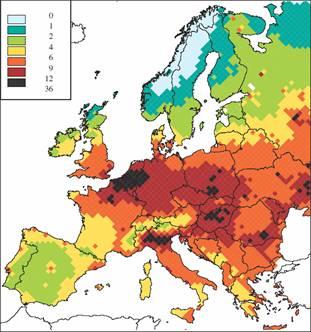Some particulates in air occur naturally, originating from volcanoes, dust storms, forest and grassland fires, living vegetation, and sea spray.But most PM is antropogenic.
Human activities, such as the burning of fossil fuels in vehicles, power plants and various industrial processes also generate significant amounts of aerosols. Averaged over the globe, anthropogenic aerosols currently account for about 10 percent of the total amount of aerosols in our atmosphere.
It is a science based fact that there is close correlation between PM pollution and allergies, asthma and other health problems of the respiratory system. The most risky grain size is 2.5 micron and less, because these very small particles are able to get into the depths of the lung and are not able to leave it. Increased levels of fine particles in the air are linked to health hazards such as heart disease, altered lung function, COPD and lung cancer.
The map on the piture shows the result of a forecast for 2020. A much higher predicted value for 2020 is shown on the map, in spite of taking a more strict regulation into consideration. The 6 month average life loss (typical in 2000 or 2004 at the more industrialized areas) increased to a value of 12−36 months.
http://www.tiszta.levego.hu/szennyezoanyagok.html
